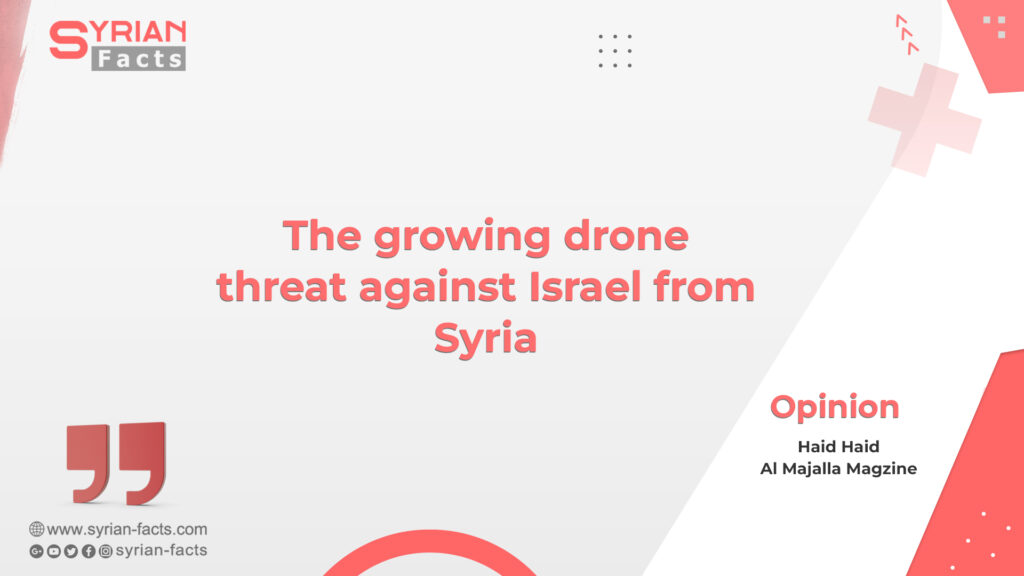On November 10, a drone reportedly launched from Syria struck the southern Israeli city of Eilat. This incident is a departure from previous attacks on Israeli-held territories, which typically involved mortar shelling confined to unpopulated areas. In contrast, this drone managed to hit a school over 400 kilometers away from the nearest point on Syrian territory.
Beyond its remarkable long-distance reach, the drone’s ability to fly undetected and hit its target suggests the involvement of a well-trained operator. The message conveyed by this attack is equally noteworthy —it demonstrates the capability of the responsible group operating from Syria to potentially target any location in Israel. The question that looms large is: who is responsible for the attack, and how did it manage to reach its target without triggering alarms?
In the early hours of Friday, the Israeli military reported that an unmanned vehicle crashed into a school in the port city of Eilat, Israel’s southernmost city. At the time of the incident, 37 students were in the school’s basement. No serious injuries were reported, but one individual suffered from smoke inhalation due to the explosion, and five others were treated for anxiety.
In response to the incident, the Israeli army issued a statement, asserting that it had targeted the organization in Syria responsible for launching the drone. However, the statement lacked specifics regarding the identity of the assailants or details about the specific target struck by the air force.
Initial reports suggested the possibility of the drone originating from Yemen. Nevertheless, analysts examining the drone fragments in photographs of the attack indicated that it was likely an Iranian-made Shahed-101 or a similar model. The Shahed-101 boasts a range of up to 700 kilometers. Given that the distance from the Yemeni border to Eilat is nearly 2,000 kilometers, it becomes apparent that the drone must have originated from a location closer to Israel. Despite this, two main theories persist regarding the launching location of the drone and the group operating it.
The prevailing assumption, seemingly embraced by the Israeli Army, is that the drone likely originated from southern Syria. Many who entertain this belief also speculate about Hezbollah’s potential involvement in the drone attack. This speculation arises from Hezbollah’s announcement about the death of seven fighters on the same day as the drone attack, without disclosing the location of their demise.
Delving deeper into the matter, local sources in Syria have claimed that the casualties suffered by Hezbollah, at least to some extent, were a consequence of the Israeli airstrike specifically targeting Hezbollah positions in the Syrian city of Homs. Significantly, this incident stands out as the deadliest single-day toll for Hezbollah members since the onset of the party’s confrontations with Israel on October 8th.
If these reports prove accurate, it indicates that Israel might harbor suspicions about Hezbollah, given its substantial influence in southern Syria, being directly involved in the drone attack. The absence of acknowledgment from either party may stem from a shared interest in preventing further escalations.
Nevertheless, some Israeli analysts contend that the drone attack originated from northeast Syria. The considerable distance of this region from the frontlines with Israel renders it a more strategic launch point for the drone compared to the southern part of Syria, which is subject to closer monitoring by Israel. These analysts have specifically implicated the Iranian-backed Imam Hussein Brigade, established in Syria in 2016, as the group responsible for the attack.
Regardless of which account accurately portrays the details of the November 10 attack, both suggest the potential for drone attacks from either location. The crucial detail lies not in the launch point but in the trajectory of the drone. All reports confirm that the drone approached Eilat from the direction of Jordan, covering hundreds of kilometers across its airspace.
The choice of Jordan as a transit route for the drone is because Israel perceives its border with it as a low-risk zone. Consequently, Tel Aviv directs its sensors, radars, and patrol aircraft to regions where the risk of attacks is deemed higher, such as southern Syria. The rugged terrain along the Jordan-Eilat border adds complexity to drone detection and provides cover for the devices approaching from a distance at low altitudes.
Moreover, the drone’s distinctive features facilitated its discreet flight to the target without triggering alarms. Its slow speed, ability to fly at low altitudes, programmable deviation from a straight path, and compact size collectively contribute to its elusive nature, presenting challenges for radar detection, especially as not all radar systems are optimized for identifying such unmanned aerial vehicles.
As ceasefire negotiations face obstacles and ground operations persist in Gaza, the recent drone attack from Syria will unlikely be the last. Anticipating this, the Israeli army is likely to bolster security measures along the Jordanian border to avoid future surprises. However, the technical challenges outlined earlier, Israel’s military engagement on various fronts, and the capability of Iranian-backed groups to deploy multiple and more advanced drones, diminish the likelihood of Israel completely neutralizing the threats posed by these unmanned vehicles.
Therefore, a diplomatic resolution for the Gaza situation stands as the only guaranteed means to prevent further escalation against Israel, both domestically and regionally.
Al Majalla Magzine









Be the first to write a comment.